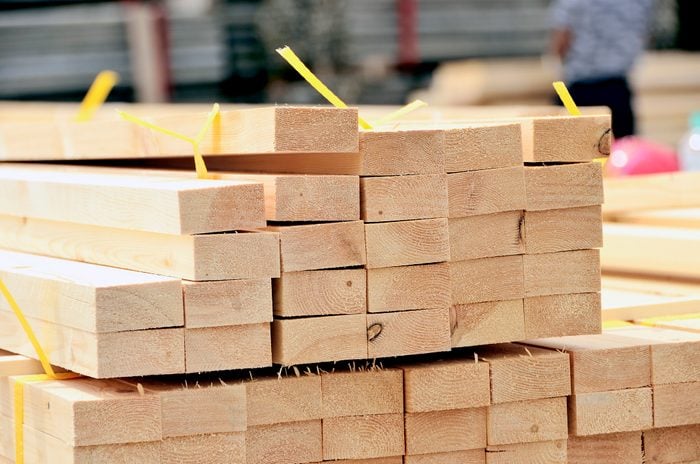What To Know About Pine Wood
Updated: Oct. 27, 2023

Wondering what you should know about pine wood before using it for a woodworking project? A pro woodworker gives his insights.
Pine is a fantastic wood. There, I said it. It has a reputation for being “builder grade,” or somehow subpar, simply because it’s readily available in most parts of the U.S. But pine is a joy to work with in the wood shop.
It works brilliantly with hand tools, machines easily, finishes well and creates an atmosphere in the shop that is pleasant to the eyes, ears and nose. I’ll walk you through everything you need to know about pine so you can use it confidently in your next woodworking project.
On This Page
What is Pine Wood?
Pine is by definition softwood, which means it comes from a conifer, those needle-leaved trees that produce seed-bearing cones often referred to as “evergreens.”
In general, pine has a creamy, yellow color to the sapwood, and a brown color to the heartwood. It is lightweight with low density, and consequently has been used for “traveling furniture” for centuries. From trunks to camp chairs, if you’ve got a project that needs to be moved regularly you may want to consider pine.
Types of Pine Wood
Pine is not a single species of tree but rather a catch-all word describing a group of conifers. There are many types to pick from. For our woodworking purposes, we’ll focus on the three most widely available in the U.S.: eastern white, southern yellow and ponderosa.
- Eastern white pine: This type of wood, light yellow with soft grain lines, is widely available in the Eastern and Northern U.S. It’s a delight to work with hand tools, but can be hard to find clear of knots. Eastern white pine often moves or warps when brought into new environments, so be sure to give the boards proper ventilation and time to acclimate to your shop before working with them. This wood is softer than most other American woods, with a Janka hardness rating of 380 lbf (pounds-force). The Janka hardness rating comes from a test that measures the density of wood species. For context, cherry has a Janka rating of 995 lbf and White Oak comes in at 1,360 lbf.
- Southern yellow pine: Also known as longleaf pine, this is the densest of these three pines, with a Janka rating of 870 lbf. It’s typically a warmer yellow than eastern white pine, with pronounced brown grain lines. Known for its durability, southern yellow pine has been used in timber framing for hundreds of years and is plentiful in the Southeastern U.S.
- Ponderosa Pine: The western cousin of eastern white pine has similar properties, including coloring and a Janka rating of 460 lbf. Although technically classified as a yellow pine, it’s considerably softer than most other yellow or “hard pine” species.
Pros and Cons of Pine Wood
Pros:
- Availability: Pine is widely available throughout the U.S. and can be purchased at almost any big box store for a quick weekend project.
- Workability: If you enjoy hand-tool woodworking, there might be no finer wood than pine. It’s truly a delight to work by hand and it leaves the workshop smelling delightful, to boot.
- Finishing: Pine takes clear film-building finishes, like shellac and urethane, with a crisp, clean warmth that I really enjoy.
Cons:
- Instability: Just because it’s readily available doesn’t mean you should use it right away. Not giving pine adequate time to acclimate to your workshop can lead to warping (and headaches).
- Machinability: While pine machines exceptionally well, it is a resinous wood that will leave pitch on your cutter heads and saw blades over time. It’s easy to clean off with soap and a stiff bristle brush, but an extra hassle nonetheless.
- Staining: Pine does not work well with wood stain or dye. You can purchase pre-stain conditioners to help balance out what is often referred to as blotchiness, but I personally recommend painting pine if you want to add some color.
What Is Pine Wood Used For?
You’ll find pine in variety of applications, including:
-
Stick frame construction: From 2x4s to window sills, many parts of modern homes are built with pine. Perhaps more than you realize!
-
Timber framing: Large pine timbers been used for centuries to create timber framed homes, barns and churches.
-
Decking: Pressure-treated pine turns up in exterior construction projects, like decks. It’s been treated with chemicals like copper and arsenic to slow rot and thwart insects.
-
Furniture: Pine has been a staple in woodworkers’ shop for centuries due to its availability and workability. It’s also used in commercially fabricated furniture (such as couches and beds) due to its light weight.
Pine Wood Cost and Purchasing
Regional availability affects pricing — southern yellow pine will be more expensive in the northeastern U.S., for instance — but it’s still relatively cheap compared to domestic hardwoods like cherry or walnut. It’s an excellent choice for beginner to intermediate woodworkers looking to improve their skills.
Expect to pay from $2.50 to $7 per board foot, depending on width and whether it’s presurfaced or in the rough. Most domestic hardwoods will cost from $5 to $15 per board foot.
Note: Other conifers are often lumped in the “pine” category that aren’t actually pine. Spruce and Douglas Fir are species used in construction-grade timbers (2x4s) called “whitewood” and are often stamped SPF (Spruce-Pine-Fir). While they’re fine for construction projects like framing, different properties make them undesirable for woodworking.
